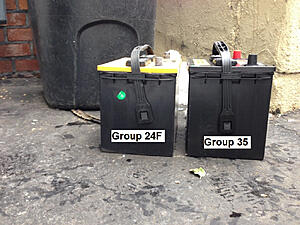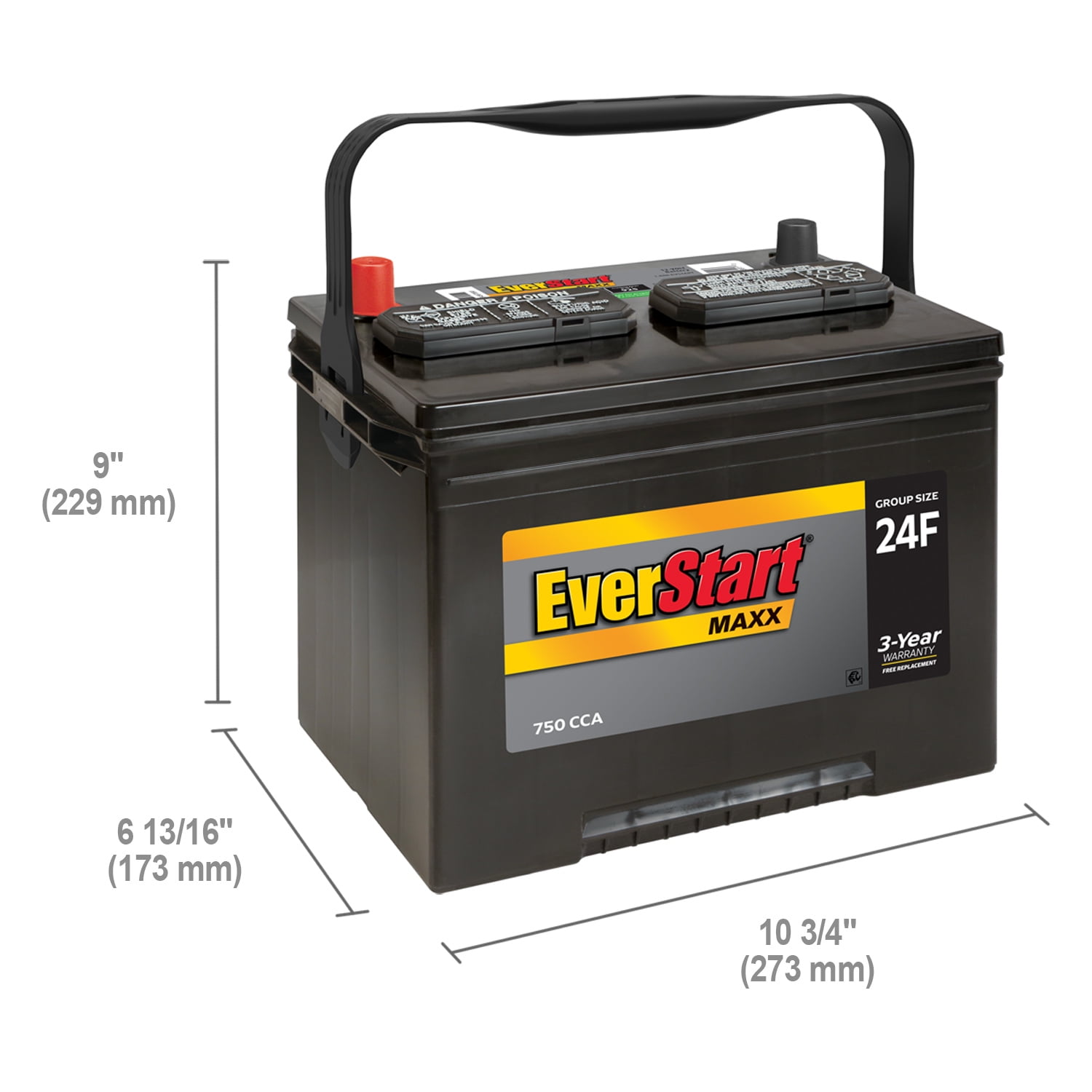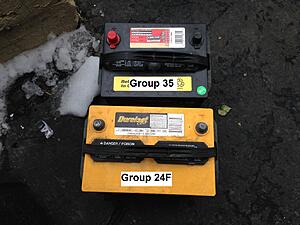The main difference between a 24F and 35 car battery is their size and power capacity. A 24F battery is larger and has more power, making it suitable for vehicles with higher power requirements, while a 35 battery is smaller and best for vehicles with standard power needs.
When choosing a car battery, it’s essential to consider your vehicle’s power requirements and the physical space available in the engine compartment. A 24F battery is typically used for larger vehicles such as trucks and SUVs, whereas a 35 battery is suitable for smaller cars and compact vehicles.
Understanding the differences between these batteries will help you make an informed decision when selecting the right one for your vehicle.

Credit: g35driver.com
Physical Dimensions
The physical dimensions of a 24F and a 35 car battery are important factors to consider when choosing the right battery for your vehicle.
Size And Weight
The 24F battery is larger and heavier than the 35 battery.
Size And Weight
- The dimensions of a 24F battery are approximately 10.87 x 6.75 x 9.75 inches.
- On the other hand, a 35 battery measures around 9.06 x 6.44 x 8.88 inches.
- The weight of a 24F battery is typically heavier at around 44-48 pounds.
- Meanwhile, a 35 battery weighs lighter at approximately 32-37 pounds.

Credit: www.walmart.com
Capacity And Power
Discover the distinction between a 24F and 35 car battery in terms of capacity and power. The 24F offers higher capacity for heavy-duty vehicles, while the 35 provides sufficient power for standard car models. Understanding these differences helps in selecting the right battery for optimal vehicle performance.
When it comes to car batteries, understanding their capacity and power is crucial. Two common types of car batteries are the 24F and 35 battery. In this section, we will explore the differences between the two in terms of voltage output and amp-hour rating.
Voltage Output
The voltage output of a car battery is an essential factor to consider when choosing the right battery for your vehicle. The 24F battery typically has a voltage output of 12 volts, which is the standard for most cars. On the other hand, the 35 battery also provides a voltage output of around 12 volts, ensuring compatibility with most automotive systems. Regardless of which battery you choose, it is important to ensure that the voltage output matches the requirements of your car.
Amp-hour Rating
The amp-hour rating refers to the battery’s capacity to deliver a certain amount of current over a specific period of time. In simpler terms, the higher the amp-hour rating, the longer the battery will last. When comparing the 24F and 35 batteries, there is a slight difference in their amp-hour ratings. The 24F battery typically has an amp-hour rating of around 70-85, while the 35 battery ranges from 45-60. This means that the 24F battery has a higher capacity and can provide more power for an extended period compared to the 35 battery.
In summary, when choosing between a 24F and a 35 battery, it is important to consider their voltage output and amp-hour rating. While both batteries provide a voltage output of around 12 volts, the 24F battery has a higher capacity with its amp-hour rating ranging from 70-85, compared to the 35 battery’s 45-60. Understanding these differences can help you make an informed decision and choose a battery that best suits your car’s requirements.
Compatibility And Interchangeability
Understanding the compatibility and interchangeability of car batteries is crucial for vehicle owners. One common dilemma is deciding between a 24F and a 35 car battery. By delving into the specifics, we can gain a clear grasp of their differences. Let’s explore the details further.
Can You Use Them Interchangeably?
When it comes to the interchangeability of 24F and 35 car batteries, it’s essential to consider their physical dimensions. While they both serve the same purpose and have similar voltage and amperage capacities, their physical sizes differ. A 24F battery is generally larger than a 35 battery, so it may not fit properly in a vehicle designed for a 35 battery. It’s crucial to ensure that the battery snugly fits in the allocated space within the vehicle’s engine compartment.
Moreover, the terminal locations of 24F and 35 batteries vary, which could pose a challenge when trying to install a battery that doesn’t line up with the vehicle’s wiring configuration. To avoid compatibility issues, it’s advisable to consult with a professional or carefully compare the specifications before attempting to use them interchangeably.
Usage And Applications
Certain applications require specific types of car batteries to ensure optimal performance and longevity. Understanding the differences in usage and applications between a 24F and 35 car battery can help you make a well-informed decision when selecting the right battery for your vehicle.
Which Is Better For Specific Applications?
When choosing between a 24F and 35 car battery, it’s essential to consider the specific applications for which each type is best suited.
- 24F Car Battery: Ideal for larger and more powerful vehicles such as trucks, SUVs, and performance cars that require a higher cold cranking amperage (CCA) for reliable starting in cold weather conditions.
- 35 Car Battery: Best suited for smaller to mid-sized vehicles with standard power requirements, such as sedans and compact cars. It is also suitable for vehicles with less electrical demand and moderate climate conditions.
Cost Comparison
The cost comparison between a 24F and 35 car battery involves evaluating the differences in price for each type. These distinctions can range depending on brand, capacity, and quality. It’s important to research and compare prices to make an informed decision.
Cost Comparison:
When it comes to choosing a car battery, cost is an important factor to consider. The initial cost of the battery itself, as well as the long-term cost in terms of maintenance and replacement, can greatly impact your budget. In this section, we will explore the cost comparison between a 24F and 35 car battery.Initial Cost:
The initial cost of a car battery refers to the price you pay upfront when purchasing the battery. When comparing the 24F and 35 car batteries, it’s essential to note that their prices may vary depending on several factors, including the brand, quality, and additional features. However, as a general comparison, the initial cost of a 24F battery is lower than that of a 35 battery.Long-term Cost:
Aside from the initial cost, the long-term cost of a car battery is equally significant. This cost includes maintenance and replacement expenses over the battery’s lifespan. When analyzing the long-term cost, you need to consider factors such as the battery’s durability and lifespan.24F batteries are known to have a longer lifespan compared to 35 batteries. This means you may need to replace a 35 battery more frequently, increasing your long-term cost. Additionally, the maintenance requirements may also differ between these two battery types, affecting the overall cost.It’s worth noting that the long-term cost can also be influenced by individual usage patterns, weather conditions, and other external factors. However, based on general comparisons, the long-term cost of a 24F battery can be more cost-effective than that of a 35 battery.In conclusion, the cost comparison between a 24F and 35 car battery consists of the initial cost and the long-term cost. While the initial cost of a 24F battery is lower, the long-term cost can potentially be more affordable due to its longer lifespan. Ultimately, the choice between these two battery types should be based on your specific needs and budget considerations.
Credit: g35driver.com
Performance Comparison
IntroductionPerformance Comparison:
Cold Cranking AmpsCold Cranking Amps
24F Battery: Provides higher cold cranking amps.
35 Battery: Offers lower cold cranking amps than 24F.
Life Expectancy
- 24F Battery: Typically has a longer lifespan.
- 35 Battery: Generally has a shorter life expectancy compared to 24F.
Conclusion
To sum up, understanding the difference between a 24F and 35 car battery is crucial when it comes to ensuring optimal performance for your vehicle. While both batteries serve the purpose of powering your car, their dissimilarities lie in factors like size, capacity, and compatibility.
By considering your car’s specifications and requirements, you can make an informed decision and choose the battery that best suits your needs. So, make sure to consult your car’s manual or seek expert advice to make the right choice.